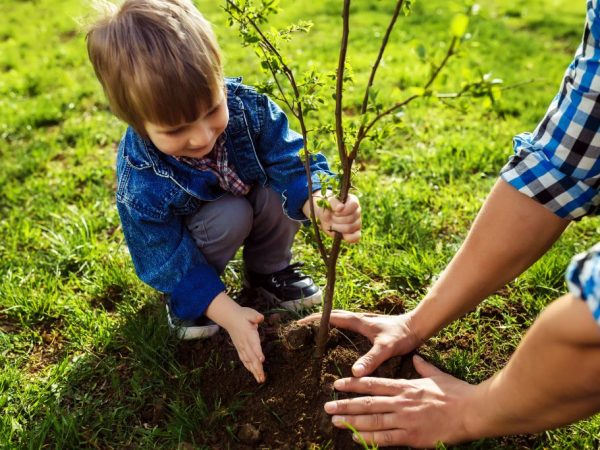Rules for planting pears in spring
Planting pears in spring is the best option for gardeners. For a culture to grow and develop well, you need to provide it with care according to the established rules.

Rules for planting pears in spring
Seat selection
The pear prefers a well-lit and heated area. This is necessary so that the fruits have time to ripen, as well as to increase yields. The place should be protected from cold winds and drafts. Trees are able to withstand temperatures down to -25 ° C, but in calm weather. The south side of the garden is ideal.
The soil
The soil for planting crops is chosen fertile and loose. The plant thrives on sandy loamy, slightly acidic soils or with a neutral pH level. groundwater should lie at a depth of at least 3 m: this will prevent rotting of the plant roots. A pear does not tolerate excess moisture, so it is better to choose a place on a hill.
The following types of soil are not suitable for growing:
- sandy;
- crushed stone;
- limestone;
- swampy.
The pear is planted at a distance of at least 3 m from buildings so that it does not create shading. For self-infertile varieties, care is taken to ensure that pollinators grow nearby.
Better to plant near an apple tree. It is not worth it next to the mountain ash, because they are affected by the same pests. The distance from other trees should be at least 5 m. It is advisable to determine the place for the plant constant, because the pear does not tolerate transplanting well.
Site preparation
Preparation is carried out in the fall. With a high level of acidity, the earth will neutralize it. For this, lime or dolomite flour is added to the soil. Be sure to monitor the amount of substances introduced, since the culture does not accept alkaline earth. Worms help to increase the looseness of the soil. If there are not enough of them on the site, they bring sod from the pasture or land from the forest.
On the swampy soil, grooves are dug along the perimeter of the site, which should go beyond the selected place. This is done to drain excess moisture. Then they equip the drainage. Dig trenches and fill them:
- stumps, trunks, branches and other substances that rot for a long time are laid on the bottom;
- mowed grass, fallen leaves, non-toxic household waste are placed on top;
- covered with earth.
Until spring, the soil will settle, then planting is carried out.
In the middle lane, loamy soils are often found. To improve them, peat, sand, rotted manure or compost are added. Distribute evenly over the site, dig up. For digging, they also give mineral fertilizers, which are applied with the calculation of 8-10 g per 1 sq. m.
Pit preparation

The seedling pit is deep enough
To plant a pear in the spring, a hole is dug in the fall. It should be about 1 m deep and 80 cm in diameter. This size will ensure proper development of the plant root system.
- 3-5 buckets of humus or manure are placed on the bottom;
- fall asleep with this mixture: 2 buckets of sand, 1 tbsp. superphosphate, 2 tbsp. l. the drug Agricol, 4 tbsp. l. potassium sulfate, laid out earth.
2 buckets of water are poured into the pit. They retreat from its middle by 30 cm, drive in a wooden peg.Its height should be up to 0.5 m above ground level. Leave until spring. During the winter period, the soil has time to settle.
Sapling selection
It is better if the planting material is zoned in the area where it is planted. The purchase of seedlings is done in a nursery or in a garden center. In the fall, the choice is much greater, so they are purchased in advance and buried in earth or sand in an inclined position.
An indicator of the health of seedlings is the absence of mechanical damage, growths, ulcers, as well as an elastic and smooth bark.
Landing
It is necessary to plant a pear in the spring when a significant drop in temperature is no longer expected.
This is done before the leaves bloom, while the trees are still sleeping. Based on the climatic conditions of the region, the procedure is performed from late March to early May.
Planting a seedling is carried out in cloudy calm weather. On the eve of manipulation, the planting pit is watered with a solution of the Kornerost preparation (3 tablets per 10 l of water). Then they make a hole to fit the root system. A small earthen mound is poured into its center. To plant a plant, you must follow these instructions:
- pre-straighten the roots of the seedling;
- dip them in a clay mash: this will ensure good contact with the ground;
- install the tree on the north side of the peg so that the root collar protrudes 5-7 cm above the soil level;
- cover with earth, shaking, then the voids will be filled;
- tamp slightly;
- tie to a peg;
- pour 2 buckets of water;
- with humus, mulch the ground around the seedling - this will help retain moisture.
Pear transplant
If there is a need to transplant a tree, then you need to choose a more suitable method, because. there are several of them. The rules for the most common method are as follows:
- the root of the pear is dug out according to the size of the crown;
- the plant, along with a lump of earth, is carefully transferred to a new place so as not to damage the root system;
- fertilized, covered with soil.
The tree is transplanted using more gentle, but long-lasting methods. In early spring, along the perimeter of the crown, they dig a trench 1 m deep, wide enough to make it convenient to perform actions. The roots are cut, the hole is filled with fertile soil. During the summer, water is added to it. By the autumn period, new fibrous roots will appear on the chopped off roots. The tree is moved in the spring. This method promotes good rooting of the plant - it tolerates the procedure better.
There is another transplant option: in the spring they dig only half of the hole, cover it with earth. The next year, at the same time, they dig the second half, and also fall asleep. A pear can be planted in a new place in the fall.
Conclusion
To properly plant a pear in the spring, you must follow all the recommendations. During the summer, they control the development of the tree. If necessary, correct it. Performing the procedure in the fall does not give such an opportunity.
There are other ways to plant a crop. Recently, the method of planting pears on a dwarf rootstock, which is used as a quince, has gained popularity.


